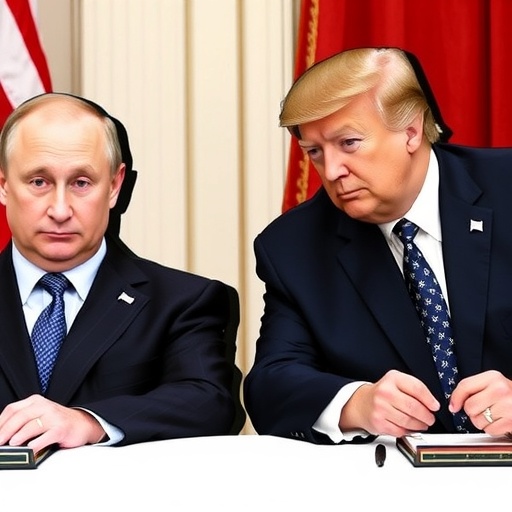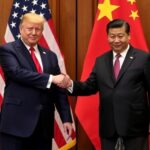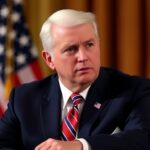Trump Cancels Putin Summit Until Ukraine Peace Deal is Secured: A Turning Point in US-Russia Tensions
In a dramatic escalation of diplomatic pressure, President Donald Trump has abruptly canceled a highly anticipated summit with Russian President Vladimir Putin scheduled for Budapest, Hungary, on Wednesday. The decision, announced late Tuesday from the White House, hinges on one unyielding condition: no face-to-face talks will proceed until a concrete peace deal is reached to end the protracted Ukraine war. This move underscores a hardening U.S. stance amid ongoing hostilities that have ravaged Eastern Europe for over two years, reshaping the contours of US-Russia relations and injecting fresh uncertainty into global security dynamics.
Trump‘s announcement came during a press briefing where he emphasized the urgency of resolving the conflict. “We’re not sitting down for tea and crumpets while Ukraine bleeds,” Trump stated firmly, his words echoing the frustration of millions affected by the war. “Putin needs to commit to a real peace deal, or there’s no meeting. Simple as that.” The cancellation not only derails what was seen as a potential breakthrough in negotiations but also highlights the deepening rift between Washington and Moscow, with implications rippling across NATO alliances, energy markets, and international law.
The Ukraine war, which erupted in February 2022 with Russia’s full-scale invasion, has claimed tens of thousands of lives and displaced over 6 million people, according to United Nations estimates. Economic fallout has been staggering: global food prices surged by 30% in the war’s first year due to disrupted Black Sea grain exports, while Europe’s energy crisis intensified as Russia curtailed natural gas supplies. Trump’s intervention signals a pivot from earlier diplomatic overtures, where the U.S. had pushed for dialogue even as military aid to Ukraine topped $50 billion since the invasion began.
Behind the scenes, sources close to the administration reveal that preparations for the Budapest summit had been underway for months. Hosted in the neutral ground of Hungary—a NATO member with historically warmer ties to Russia—the meeting was envisioned as a venue for direct talks on de-escalation. Yet, recent intelligence reports of Russian troop buildups near the Ukrainian border and stalled ceasefire discussions in Geneva prompted the White House to pull the plug. “This isn’t a bluff,” a senior U.S. official told reporters anonymously. “The president is drawing a red line to force progress on the peace deal.”
Trump’s Bold Diplomatic Gambit Against Putin’s Ukraine Strategy
President Trump’s decision to cancel the summit represents a calculated escalation in his approach to the Ukraine war, blending his signature deal-making rhetoric with a firmer line on Russian aggression. Long known for his admiration of strongman leaders, Trump has navigated a complex path with Putin since returning to office. During his first term, summits in Helsinki and Singapore yielded mixed results, but the current crisis demands a different tack. By tying the meeting to a peace deal, Trump is leveraging U.S. influence to pressure Russia into concessions, such as withdrawing forces from occupied territories in Donetsk and Luhansk regions.
Analysts point to recent battlefield developments as a key factor. Ukrainian forces, bolstered by Western-supplied HIMARS rocket systems and Leopard tanks, have reclaimed over 8,000 square kilometers since last summer’s counteroffensive, per the Institute for the Study of War. Yet, Russia maintains control of approximately 18% of Ukraine’s territory, including Crimea, annexed in 2014. Trump’s team argues that without a summit, Putin risks further isolation: U.S.-led sanctions have already frozen $300 billion in Russian central bank assets and barred Moscow from SWIFT financial messaging systems.
In a statement released Wednesday morning, the White House outlined specific demands for any peace deal. These include Russia’s full withdrawal from Ukrainian soil, reparations for war damages estimated at $400 billion by the World Bank, and international guarantees for Ukraine’s sovereignty. “President Trump is committed to ending this senseless Ukraine war, but not at the expense of American interests or Ukrainian freedom,” Press Secretary Karine Jean-Pierre affirmed. The gambit echoes historical precedents, like President Reagan’s 1983 boycott of arms control talks with the Soviets over Afghanistan, which ultimately contributed to Cold War thaw negotiations.
Critics within the U.S. political spectrum have mixed reactions. Republican hawks like Senator Lindsey Graham praised the move as “tough love for Putin,” while some Democrats worry it could provoke escalation. House Speaker Mike Johnson, a Trump ally, tweeted: “No more empty talks—time for a real peace deal that secures Ukraine and deters Russia.” Domestically, the announcement boosts Trump’s image among voters concerned with foreign entanglements, with polls from Pew Research showing 62% of Americans favoring a negotiated end to the conflict.
Inside the Canceled Budapest Summit: From Hope to Stalemate
The Budapest summit was poised to be a landmark event, building on indirect talks mediated by Turkey and Qatar earlier this year. Hungarian Prime Minister Viktor Orbán, a vocal critic of EU sanctions on Russia, had lobbied aggressively to host the meeting, viewing it as a chance to position Budapest as a diplomatic hub. Invitations were extended in late 2023, with agendas focusing on humanitarian corridors, prisoner exchanges, and preliminary peace deal frameworks. Security preparations included deploying 2,000 Hungarian troops and coordinating with Interpol for high-level protection.
However, cracks emerged in the lead-up. Russian state media, via TASS, had touted the summit as evidence of Putin’s diplomatic prowess, while Ukrainian President Volodymyr Zelenskyy warned against any concessions without ironclad guarantees. A leaked diplomatic cable from the U.S. State Department, cited by The New York Times, revealed concerns over Putin’s reluctance to discuss Crimea’s status—a non-negotiable for Kyiv. “The peace deal must address root causes, not just symptoms,” Zelenskyy said in a CNN interview Tuesday, adding, “We appreciate Trump’s pressure on Putin, but words must turn to action.”
Logistically, the cancellation disrupts more than just talks. Delegations from both sides, including 50 U.S. officials and a comparable Russian contingent, were en route when the news broke. Airlines reported last-minute cancellations, and Budapest hotels refunded bookings tied to the event. Economically, Hungary stands to lose from foregone tourism boosts, estimated at €10 million. On the Russian side, Kremlin spokesman Dmitry Peskov downplayed the snub, calling it “an American ploy to deflect from Ukraine war failures.” Yet, privately, Moscow sources indicate frustration, as the summit offered a platform to ease sanctions amid Russia’s 7.5% inflation rate and ruble volatility.
Historical parallels abound: The 2014 Minsk agreements, aimed at resolving the Donbas conflict, collapsed under similar trust deficits. Experts like Fiona Hill, former National Security Council advisor, argue that Trump’s cancellation could reinvigorate multilateral efforts. “By raising the stakes, the U.S. is forcing all parties back to the table,” Hill wrote in a Foreign Affairs op-ed. Data from the Stockholm International Peace Research Institute shows global military spending hit $2.24 trillion in 2023, with the Ukraine war as a primary driver—making a peace deal not just desirable, but essential.
Global Ripples: How the Ukraine War Peace Deal Delay Affects Allies and Adversaries
The cancellation’s shockwaves extend far beyond Washington and Moscow, altering alliances in the Ukraine war theater. NATO Secretary General Jens Stoltenberg welcomed Trump’s firmness, stating in Brussels, “This reinforces our unity against Russian aggression.” The alliance, which has admitted Finland and Sweden since the invasion, now eyes further expansion; Poland and the Baltics have ramped up defenses with $20 billion in new procurements. Yet, divisions persist: Turkey’s President Erdogan, a key grain deal broker, expressed disappointment, warning of renewed Black Sea tensions that could spike global wheat prices by 15%.
In Asia, China’s role complicates matters. Beijing, which abstained from UN votes condemning Russia, has positioned itself as a peace broker, proposing a 12-point plan in February 2023. State Councillor Wang Yi reiterated support for talks but criticized U.S. “hegemony” in a Wednesday speech. Economically, the delay hampers Russia’s pivot to BRICS partners; trade with India and Brazil has grown 40%, but sanctions limit full benefits. Energy markets reacted swiftly: Brent crude dipped 2% to $82 per barrel on news of stalled diplomacy, while European LNG imports from the U.S. hit record highs.
Humanitarian impacts are stark. The UN Refugee Agency reports 10 million Ukrainians in need of aid, with winter looming as a crisis multiplier. Organizations like Doctors Without Borders have documented over 500 attacks on medical facilities. Trump’s move, while diplomatic, risks prolonging suffering; a recent Red Cross assessment estimates $15 billion annually in reconstruction costs post-peace deal. On Capitol Hill, bipartisan legislation like the Ukraine Security Supplemental Appropriations Act allocates another $61 billion, signaling sustained U.S. commitment.
Public opinion worldwide leans toward resolution. A YouGov poll across 10 countries shows 70% favor a negotiated Ukraine peace deal, even if it involves territorial compromises. In Russia, state-controlled Levada Center surveys indicate 55% support for talks, up from 40% last year amid war fatigue. For Putin, the cancellation isolates him further; his inner circle, including Foreign Minister Sergey Lavrov, faces mounting pressure to adapt strategies beyond military means.
Path Forward: Navigating US-Russia Standoff Toward Ukraine Resolution
As the dust settles on the canceled summit, eyes turn to alternative venues for advancing a Ukraine peace deal. The United Nations General Assembly in September could serve as a neutral ground, with Secretary-General António Guterres urging “immediate and unconditional” talks. European leaders, including France’s Emmanuel Macron and Germany’s Olaf Scholz, propose a Paris-Berlin axis for mediation, building on the Normandy Format’s legacy. Meanwhile, the U.S. plans to intensify sanctions, targeting Russia’s shadow fleet of oil tankers that evade caps, potentially reducing Moscow’s revenues by $10 billion yearly.
Trump’s administration hints at incentives for progress: lifting select sanctions in exchange for verifiable de-escalation, such as halting missile strikes on civilian infrastructure. Intelligence sharing with Ukraine will continue, with new F-16 jets arriving by year’s end to bolster air defenses. On the Russian front, Putin may counter with asymmetric measures, like deepening ties with North Korea for munitions—already supplying 1 million artillery shells, per U.S. estimates.
Long-term, a successful peace deal could redefine global order. Experts forecast a “new Yalta” moment, redrawing European security lines and curbing hybrid threats. The Atlantic Council warns of escalation risks, including nuclear saber-rattling, but optimism persists: Track-II dialogues between U.S. and Russian think tanks have yielded informal cease-fire ideas. As Trump prepares for domestic priorities, his Ukraine war stance will shape his legacy—potentially as the dealmaker who ended Europe’s largest conflict since World War II. Stakeholders from Kyiv to Kyiv await signals of thaw, knowing that diplomacy’s clock ticks amid the ruins.









